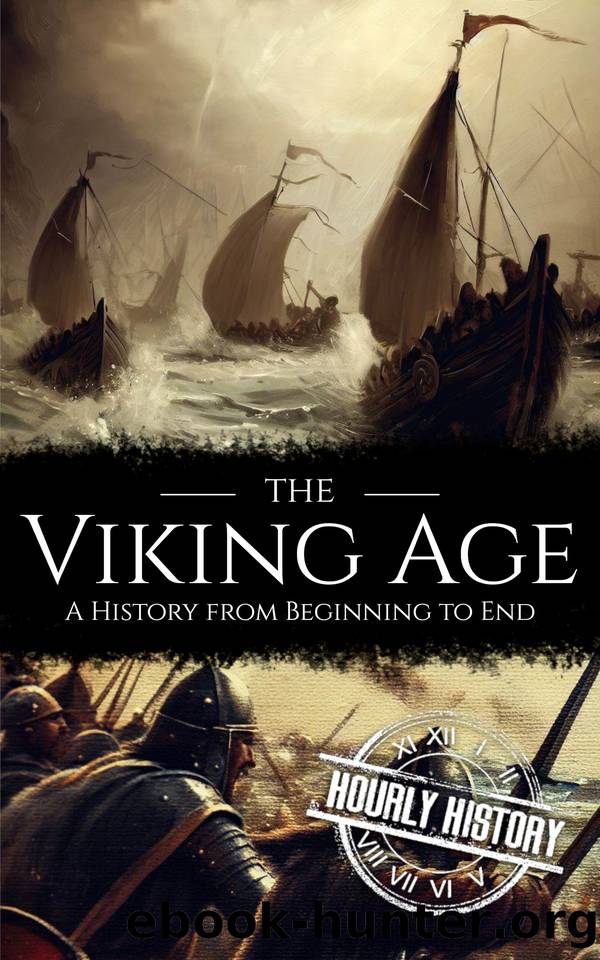The Viking Age: A History from Beginning to End (Viking History) by History Hourly

Author:History, Hourly
Language: eng
Format: epub
Publisher: Hourly History
Published: 2023-07-09T00:00:00+00:00
Chapter Seven
Viking Warriors
âFear not death, for the hour of your doom is set, and no one may escape it.â
âViking saying
Although the Vikings produced many very successful merchants and traders, it was the warriors who characterized this society. Only valiant warriors could gain admission to Valhalla or Fólkvangr, and the greatest respect within Viking society seems to have been shown to the bravest and most effective warriors.
Viking armies were generally relatively small, usually less than 1,000 men. Jarls acted as warlords or generals, and the bulk of troops were freemen, the karls. Each region controlled by a jarl also had a hersir who was responsible for allocating karls to act as warriors and to take part in raids. Because they were relatively small, Viking armies did not have the kind of complex ranking system seen in contemporary European armies. The jarl decided on overall strategy, and the karls fought more or less as a mass of independent warriors. However, there were a few specialized roles in Viking armies, some of which have become famous.
Most notable were the berserkers, one of the most misrepresented Viking warriors. These were not simply warriors crazed with bloodlust, as fiction would have us believe, but shamanic warriors who performed a particular role within a Viking army, often acting as the personal bodyguard to a particular jarl. Like all shamanic Viking warriors, berserkers were linked to an animal totem: the bear. They would wear frightening costumes made from bearskins and were noted for their willingness to fight to the death when required. Other shamanic Viking warriors included the ulfhednar, who wore wolfskin costumes, and the svinfylking, who took the wild boar as their totem.
Not all elite Viking troops were shamanic. The Jomsvikings were troops commonly used as bodyguards and shock troops. Their corps stressed physical strength and courage, and membership of this group was limited to the boldest and bravest of all Viking warriors. Collectively, these elite troops were known as housecarls because they were generally associated with the ruling house of a particular jarl.
Viking warriors were armed and armored according to what they could afford; thus weapons became an expression of social status as well as tools of warfare (Viking warriors would keep their weapons close to hand at all times, hanging them on the end of the bed while they slept). Turning iron into weapons was a long, labor-intensive process, making weapons expensive. Most expensive of all was the sword, generally owned only by jarls and the wealthiest Vikings. These were around three feet (one meter) long, often lavishly decorated, and sometimes given personal names such as Skrofnung (âGnawerâ), Nadr (âViperâ), and Naegling (âHole-makerâ). The swords were worn in a scabbard hung over the shoulder, and some jarls also carried sax (short swords).
Battle axes were the next most expensive weapons, and these too were often finely decorated (one discovered Viking battle axe dating to the tenth century includes rich gold inlay). Cheapest of all were iron-tipped spears and bows and arrows, which were probably used by most Viking warriors.
Download
This site does not store any files on its server. We only index and link to content provided by other sites. Please contact the content providers to delete copyright contents if any and email us, we'll remove relevant links or contents immediately.
| General | Copenhagen |
Room 212 by Kate Stewart(4108)
The Crown by Robert Lacey(4108)
Endurance: Shackleton's Incredible Voyage by Alfred Lansing(3847)
The Iron Duke by The Iron Duke(3641)
The Rape of Nanking by Iris Chang(3518)
Killing England by Bill O'Reilly(3458)
Joan of Arc by Mary Gordon(3260)
Say Nothing by Patrick Radden Keefe(3062)
I'll Give You the Sun by Jandy Nelson(2842)
Hitler's Monsters by Eric Kurlander(2734)
Shadow of Night by Deborah Harkness(2720)
Margaret Thatcher: The Autobiography by Thatcher Margaret(2687)
Mary, Queen of Scots, and the Murder of Lord Darnley by Alison Weir(2679)
Darkest Hour by Anthony McCarten(2649)
Blood and Sand by Alex Von Tunzelmann(2610)
Red Famine: Stalin's War on Ukraine by Anne Applebaum(2466)
Eleanor & Park by Rainbow Rowell(2395)
The One Memory of Flora Banks by Emily Barr(2349)
Book of Life by Deborah Harkness(2265)
